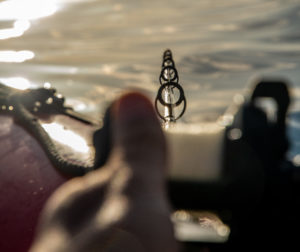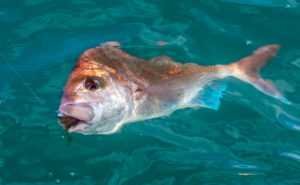NZFN have kindly given permission for FishCare to reproduce this article, originally published 2014.

Fish for fish, they produce far, far more eggs than the small ones, too (a three-year-old fish can produce 250,000 eggs, whereas a 10-year-old fish may produce 5,000,000 eggs).
Another side to the coin is that these big old fish have tougher, coarser flesh so are not great eating, with some help required to make them reasonably palatable. It is almost a knee-jerk reaction for many fishermen to say, when a big snapper is slipped into the net (one they can’t bear to release because of its bragging value): “Here’s one for the smoker”.
But if our primary motivation is fishing for the table (as well as enjoying the outdoors, some time with friends and family, and a battle with a fish), then 1-4kg fish produce decent-sized, top-quality fillets and fight well enough on the ‘light’ tackle many anglers now commonly use, making them ideal captures under the new fisheries regulations.
How, then, do we target these desirable, modest-sized snapper, while avoiding the lesser fish, particularly in the inner Hauraki Gulf, and by extension, in other parts of SNA1?
With bait
In a nutshell, bigger baits catch bigger fish. But if targeting some nice pannies in the 1-4kg range say, you don’t want to go over the top with mega baits like big skipjack heads or whole kahawai fillets. What is needed is an attractive (to the fish) bait of a size only a reasonable fish can take in its mouth, which is also robust enough to survive the attentions of small fish worrying away at it for a reasonable period of time.
 A common baitfish that ticks all these boxes is the jack mackerel. Called yellowtail by some, these hardy little baitfish are very common in the inshore waters of SNA1, and I like to use them fresh for best results. Small kahawai, trevally (just over the minimum legal size of 25cm) or modest grey mullet also fit this bill, but pilchards are too soft to last the attention of the pickers for long.
A common baitfish that ticks all these boxes is the jack mackerel. Called yellowtail by some, these hardy little baitfish are very common in the inshore waters of SNA1, and I like to use them fresh for best results. Small kahawai, trevally (just over the minimum legal size of 25cm) or modest grey mullet also fit this bill, but pilchards are too soft to last the attention of the pickers for long.
After the anchor, the next thing that goes over the side is the berley bomb, heavily weighted and set so it sits about a metre above the bottom, where the currents can run its trail to best advantage (this position may need to be adjusted as the tide rises or falls).
You can start fishing with weighted stray-lines rigged with 5/0-6/0 circle hooks and cut baits (usually strips of skipjack that have been salted to toughen them). Within 30 minutes the berley will usually have drawn a school of jack mackerel (and maybe the odd kahawai or trevally) to the boat, so a dedicated bait rod, rigged with a set of sabiki flies, can easily harvest these for fresh baits as required.
To rig the whole or half mackerel baits, a moderate to heavy stray-line rig (about 10-15kg braid or mono with a 15-24kg mono leader) is weighted with a running sinker on the leader; about 1oz usually suffices. A beak-type hook of 7/0-8/0 is tied on the end of the leader, while a similar-sized circle hook is used as a sliding keeper above this (note that sliding keepers are not IGFA compliant, so you need to snood them on if competition or club rules so require).
A decent-sized mackerel will produce just two baits; I cut them in half towards the back end of the gut cavity. My favourite piece is the head end, as it is tough, robust and contains most of the gut. The gut section of any baitfish is the most popular with snapper and also helps create a good scent trail, but I have caught plenty of good fish on the tail section, too – or, you can use the baitfish whole.
I rig half-fish baits by threading the beak hook through the bait a couple of times to anchor it well, then set up the hook towards the back end of the bait (by the gut) with the point well exposed. Next, the circle keeper hook is positioned on the trace to suit the length of the bait (I wind the leader around the circle hook’s shank three times so the line friction holds the hook in position) before passing the point through the nose of the bait.
 I usually cast this bait a reasonable distance from the boat, back down the berley trail, as the bigger fish tend to hang back a bit. The big, robust bait will often attract plenty of activity from smaller fish, which will rag away at it, but are not often hooked. I think that this feeding activity helps attract the attention of bigger snapper, which will swoop in and shoulder their smaller brethren aside, before scoffing down the prize. For this reason, it is important not to strike at the initial bites of smaller fish, instead waiting for the big hit.
I usually cast this bait a reasonable distance from the boat, back down the berley trail, as the bigger fish tend to hang back a bit. The big, robust bait will often attract plenty of activity from smaller fish, which will rag away at it, but are not often hooked. I think that this feeding activity helps attract the attention of bigger snapper, which will swoop in and shoulder their smaller brethren aside, before scoffing down the prize. For this reason, it is important not to strike at the initial bites of smaller fish, instead waiting for the big hit.
The hardy bait should be able to withstand a fair amount of attention before needing to be replaced. I normally fish this rod in the holder until it loads up and the drag starts howling. Often these bigger fish will hook themselves, and in the meantime, if you want, you can go on catching the mostly smaller (but still often worthwhile) fish on smaller cut baits.
You can also use small to medium jack mackerel as live baits for snapper (with a useful by-catch of john dory and sometimes even kingfish), but I reckon if snapper are not feeding aggressively, giving them something that they can smell from a distance and don’t have to chase is the best option.
With lures
There is little doubt in my mind that you tend to catch a better class of snapper on lures – whether metal jigs, soft-plastics, slow-jigs, hard-bodies or whatever – than you do using average-sized cut baits. This, I consider, is because little fish are more intimidated by lures and also not physically big enough to engulf a lure in a manner that makes a hook-up a good chance.
This aspect can be further influenced by the size of the lure used. In general terms, bigger lures tend to catch bigger fish (although bigger lures will also usually catch fewer fish – in a standard population pyramid there aren’t as many of the larger ones around as there are smaller ones).
My usual preference in the shallower, inshore spots is for soft-plastic lures. The trick here is to use a lure of the right size that’s also right for the situation. For example, with a lot of small fish around, using 3-inch soft-baits will still see you hooking ‘throwbacks’ all day, so save these little lures for times when the better fish become fixated on tiny prey, such as juvenile anchovies, in shallow water.
However, using slightly larger lures sees the balance swing. Softies in the 4- to 5-inch bracket will help intimidate the little guys, and those that do have a crack usually tend to pull at the soft-bait’s tail and are not often hooked – and you don’t want to catch them anyway with the new increase in minimum-size regulations. Using tougher types of soft-baits will preserve them from the attentions of small fish.
If you want to put all the money on the table, you might try even larger lures (such as 7-inch soft-baits) to target the largest available fish. But remember, if the medium-sized table fish are not feeding aggressively, you are likely to miss out on what might be a useful catch.


